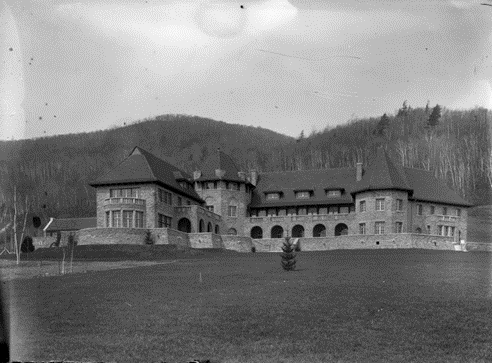APS TOGETHER
Day 7
The Haunting of Hill House by Shirley JacksonChapter 4, Part 1 – first half
October 16, 2023 by Ruth Franklin
All the little ways in which Eleanor’s insecurity manifests itself—and shades almost imperceptibly into paranoia, from her worries about how Theodora perceives her to her FOMO (or being left out). Her mood, too, shifts suddenly from well-being (the result of her good night’s sleep? Or some deeper sense of her at-home-ness in Hill House?) to irritability with the others. Is she the only one who really takes the house seriously? Or is willing to face its reality?
What do we make of Mrs. Dudley’s robotic affect? “I clear off at ten… The silver belongs in the silver chest… The glasses belong on the shelves.” She’s got her lines and she’s sticking to them, unwilling to be drawn into another kind of conversation. Could this be her way of asserting control over the chaos of Hill House, drawing a boundary to keep herself safe?
Meanwhile, Luke and Theodora are unwilling to limit their talk to what’s in front of them—every room provokes a new reverie about themselves (“Where Eleanor and I will go each morning with our needlework) or about the house’s prior inhabitants (“Jolly spot to spend a carefree hour”). They both use fantasy and irony to deflect the seriousness of the undertaking. Eleanor is unable to.
More on the floor plan of Hill House: concentric circles, inside versus outside rooms, the verandah that goes all the way around. In reference to the tower, for the first time we have proof that Eleanor, who sympathizes with the lonely companion more than with the abandoned children, is tuned in to Hill House on a frequency that the others can’t hear—or, in this case, smell.
As I mentioned in a previous post, I believe the Everett Mansion was one of Jackson’s primary inspirations. It’s located in Bennington, Vermont, just a few miles from Jackson’s home, and has its own set of spooky myths that resemble slightly the ones in the novel. And, as I wrote in the essay linked earlier, I was spooked myself when I stumbled upon it by accident. What do you think? This photo shows what it looked like closer to Jackson’s time.

Jackson first played with the idea of a house with a haunted tower in an earlier story called “A Visit: Or, the Lovely House,” published in 1952. She called it one of her favorite stories, and it’s also one of mine. It’s so mysterious and uncanny that it really can’t be paraphrased. A girl named Margaret visits a friend who lives in a beautiful house in the countryside, a storybook mansion surrounded by a river and hills, with walls bedecked with tapestries and a room with a stone mosaic on the floor depicting a girl’s face, with the caption underneath: “Here lies Margaret, who died for love.” Soon the friend’s brother arrives with Paul, a friend of his own, who charms and seduces Margaret, taking her on picnics and telling her the history of the house, which includes an elderly great-aunt who lives in the tower. Her name, too, is Margaret, and when the younger woman visits her, she is distressed to hear that Paul has returned: “He should have come and gone sooner,” she says, “then we’d have it all behind us.” The story is so subtly, beautifully unspooled that what is real and what is imaginary won’t become apparent until the very end. I can’t find it online, but it’s in several collections of Jackson’s work, including the Library of America edition. More about it here.
